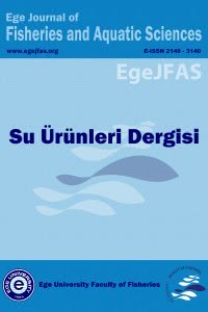Çipura (Sparus aurata) balıklarının farklı yemlere olan atak modelleri ve yetiştiricilikte kullanımı
yemleme, pelet, gıda tüketimi, balık beslenmesi, kültür balığı, beslenme davranışı
Foraging patterns to different food types of the gilthead seabream (Sparus aurata) and use in aquaculture
feeding, pellets, food consumption, fish feeding, fish culture, feeding behaviour,
___
Andrew, J. E., M. L. Begout Anras, J. Holm, S. Kadri, F. A. Huntingford, 2003. Feeding responses of hatchery-reared gilthead seabream (Spams aurata) to a commercial diet and naturel prey items. Mar. Freshw. Behav. Physiol. 36:77-86.Andrew, Ü. E., J. Holm, F. A. Huntingford, 2004a. The effect of pellet texture on the feeding behaviour of gilthead seabream ( Sparus aurata). Aquaculture, 232:471-479.
Andrew, J. E., J. Holm, S. Kadri, F. A. Huntingford, 2004b. The effect of competition on the feeding efficiency and feed handling behaviour in the gilthead sea bream (Spams aurata) held in tanks. Aquaculture, 232:317- 331.
Andrew, J. E., C. Noble, S. Kadri, H. Jewll, F. A. Huntingford, 2002. The effect of demand feeding on swimming speed and feeding responses in Atlantic salmon Salmo satar L, gilthead seabream Sparus aurata L. and European sea bass Dicentrarchus labrax L. in sea cages. Aquaculture Research, 33:501-507.
Artigas, E. G. 1999. Feeding policy for marine fish. Pro Aqua Nutricion, Spain, pp.21-22.
Başaran, F., K. Fırat, Ş. Saka, H. Şen, 2000. Dip trol ağları ile yakalanan mırmır(Lithognathus mormyrus), mercan(Pagellus erytrinus), barbun (Mullus barbutus), isparoz(Diplodus annularis) türlerinin kültür koşullarına adaptasyonu ve hareket davranışlarının gözlenmesi, Hayvancılık Araştırma Dergisi, 10(1-2): 51-56.
Başaran, F. 2004. Kültürü yapılan levrek (Dicentrarchus labrax L.1758) balığının larval gelişim dönemlerindeki davranış özelliklerinin video görüntüleme tekniği kullanılarak belirlenmesi. Fen Bilimleri Enstitüsü. Ege Üniversitesi. Doktora tezi, 142 s.
Baynes, S. M., B. R. Howell, T. W. Beard, J. D. Hallam, 1994. A description of spawning behaviour of captive dover sole, Solea solea (L), Netherlands Journal of Sea Research, 32(3-4): 271-275.
Brown, J. A., D. Wiseman, P. Kean, 1997. The use of behavioural observations in the larviculture of cold-water marine fish, Aquaculture, 155:297-306.
Carter, C. G., G. J. Purser, D. F. Houlihan, P. Thomas, 1996. The effect of decreased ration on feeding hierarchies in groups of greenback flounder (Rhombosolea tapirina) Biol. Assoc. UK, 76:505-516.
Chen, S. C, 1956. A history of domestication and the factors of the varietal formation of the common goldfish, Carassius auratus, Sci. Sin., 5: 287- 321.
Clark, I. S., 1986. The interaction of factors influencing the predatory behaviour of the pike, Esox lucius, Phd thesis, Universty of Leicester, 176p.
Demir, N., 1992. İhtiyoloji, İstanbul Üniversitesi Yayınlarından, Sayı: 3668 (-219), İstanbul, 350s.
Dill, P. A., 1977. Development of behaviour in alevins of Atlantic salmon, Salmo salar, and rainbow trout, S. gairdneri, Anim. Behav., 25:116-121.
Fernandez-Diaz, C, E. Pascual, M. Yufera, 1994. Feeding behaviour and prey size selection of gilthead seabream, Sparus aurata, larvae fed on inert and live food. Marine Biology, 118:323-328.
Ferno, A., D. Furevik, I. Huse, A. Bjordal, 1988. A multiple approach to behaviour studies of Atlantic salmon reared in marine net pens. Int. Council for the Exploration of the Sea. Council Meeting F15,15s.
Godin, J.J., W. Rangeley, 1989. Living in the fast line, effects of the cost of locomotion on foraging behaviour in juvenile Atlantic salmon. Animal Behaviour, 37:943-954.
Grant, J. W. A., 1990. Aggressiveness and the foraging behaviour of young- of-the-year brook charr (Salvenilus fontinalis). Can. Joum. of Fish, and Aqua. Sci.47:915-920.
Hammer, C, 1997. The spontaneous swimming activity of juvenile whiting (Merlangius merlangus L.) and cod {Gadus morhua L.) under tank conditions, with regard to feeding levels. The Archive of Fishery and Marine Research. 45(1): 1-17.
Hart,P. J. B., 1986. Foraging in Teleost Fishes. The Behaviour of Teleost Fishes, J. T. Pitcher, (ed.), Croom Helm. Ltd., Worcester, 211-235.
Hughes, R. N., M. J. Kaiser, P. A. Mackney, K. Warburton, 1992. Optimizing foraging behaviour through learning, Journal of Fish Biology, 41:77-91.
Hunter, J. R., 1972. Swimming and feeding behaviour of larval anchovy, Engraulis mordax. U.S. Fish. Bull. 74:81-88.
Miyazaki, T., R. Masuda, S. Furuta, K. Tsukamoto, 2000. Feeding behaviour of hatchery-reared juveniles of the Japanese flounder following a periodof Starvation, Aquaculture, 190:129-138.
Niimi, A. J., F. W. H. Beamish, 1974. Bioenergetics and growth of largemouth bass (Micropterus salmoides) in relation to body weight and temperature. Canadian Journal of Zoology, 52:447-456.
Özbilgin, H., F. Başaran, D. Y. Özbilgin, 2004. Barbun, ısparoz, çipura ve mercan balıklarının yüzme dayanımları ve maksimum gönüllü yüzme hızlarının ölçülmesi. Türkiye Bilimsel ve Teknik Araştırma Kurumu, YDABAG, no; 102Y126,33 s.
Skiftesvik, A. B., 1992. Changes in behaviour at onset of exogenous feeding in marine fish larvae, Canadian Journal of Fisheries and Aquatic - Sciences, 49(8): 1570-1572.
Thorpe, J. E., C. Y. Cho, 1995. Minimising waste through bioenergetically and behaviourally based feeding strategies. Water Sci. Technol. 31:29-40.
Velazquez, M., S. Zamora, F. J. Martinez, 2004. Influence of environmental conditions on demand-feeding behaviour of gilthead seabream (Spams aurata). J. Appl.lchthyol. 20:536-541.
- ISSN: 1300-1590
- Yayın Aralığı: 4
- Başlangıç: 1984
- Yayıncı: Aynur Lök
Öğrenci penceresinden su ürünleri ve mühendisliği
Ahmet G. Elbek, Hülya SAYGI, Nesli YILDIZ
Sevim POLAT, M. Perçin OLGUNOĞLU, Akiz Ayça AKA, Tufan KORAY
Sinagrit (Dentex dentex (L., 1758) larva yetiştiriciliğinde kullanılan üretim teknikleri
CÜNEYT SUZER, DENİZ ÇOBAN, H. Okan KAMACI, Şahin SAKA, Kürşat FIRAT
Sakaryabaşı Batı Göleti' nde (Türkiye) sedimentten fosfor salınımının tahmini
Kutsal GAMSIZ, Atilla G. ALPBAZ
Yüzer ağ kafeslerde tilapia yetiştiriciliği
Meryem ARSLAN, SAHİRE KARAYTUĞ, BEDİİ CİCİK
A new locality for Rana ridibunda caralitana Arıkan, 1988 (Anura: Ranidae) in the Central Anatolia
DİNÇER AYAZ, CEMAL VAROL TOK, AHMET MERMER, MURAT TOSUNOĞLU, MURAT AFSAR, KERİM ÇİÇEK
B. Ahmet BALCI, Ramazan İKİZ, Beria Falakalı MUTAF
